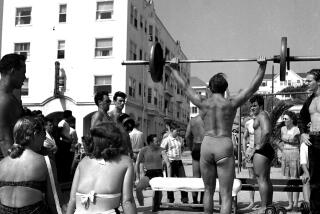Americans Not Having as Much Fun in the Sun
- Share via
People who enjoy themselves outdoors are more content with their lives, their families, and their jobs.
Philosophers and poets have been saying this for ages. After World War II, Southern California grew mighty on the premise. Then, four years ago, a trade group representing the outdoor recreation industry surveyed Americans and arrived at the data to prove it.
Just about half the country participates regularly in some outdoor activity. This was the happiest half of the country, the study found.
As Ralph Waldo Emerson put it back in 1841: Who leaves the pine-trees, leaves his friend,Unnerves his strength, invites his end.
Given society’s eagerness to fashion a trend out of almost anything that promises happiness, the survey results might suggest a national rush to get outside and play.
For a few years, such a trend seemed to be brewing. But this year, America’s RQI--Recreational Quality Index--took its first dip. And for some Americans, including working women, the dip was more like a plunge.
RQI is a measure devised by the Recreation Roundtable, a group of outdoor recreation businesses, using the polling and expertise of the independent Roper Starch survey research firm. The index is a combination of three values: how frequently Americans venture into the outdoors, their satisfaction with the experience, and whether they perceive outdoor recreation opportunities as adequate.
Results from 1994 became a baseline scale of 100. In 1995, the index rose to 107 and the next year to 109. This year, it dropped to 104. Perceived opportunity remained static in the findings, in which satisfaction waned. The big decline was in participation.
Women in particular are staying indoors more. The RQI was down 8 points for all women, 11 points for women ages 18 to 49, and 12 points for working women.
Younger Americans were down. African Americans were way down. Single Americans were down 13 points. Outdoor vacations were down. Decline was evident in all regions of the country.
This said, Roundtable Executive Vice President Derrick A. Crandall was not downcast when reached by telephone at his Washington, D.C., headquarters. “There are trends and indicators that are not where they ought to be,” he allowed. But he qualified his assessment: “Basically, we’re optimistic.”
*
Why so upbeat? A couple of reasons. Baby boomers, whom Crandall describes as “clearly the most recreational generation America has known,” have reached their optimum earning potential. That is, boomers have the means to spend money. That’s important to the recreation industry. Secondly, those Americans pollsters define as “influentials,” the 8% or so of the population who shape trends and policies, are twice as likely as others to be outdoor enthusiasts.
The roundtable is composed of manufacturers like Coleman, equipment purveyors like L.L. Bean and REI, private concessionaires on public lands, and various ancillary firms from Disney to Times Mirror, publisher of 10 outdoor-recreation magazines as well as The Los Angeles Times.
Business is not alone in meditating on the subject. The Senate Committee on Energy and Natural Resources has begun hearings on the state of outdoor recreation in America. And books touching on the subject are hot topics.
Geoffrey Godby is coauthor of “Time for Life” and professor of leisure studies at Penn State. He has monitored how Americans spend their days and deduced this: “Ninety-four percent of our time is spent indoors.”
Two facts of life bode poorly for outdoor recreation, as Godby sees it. The U.S. population is getting older, and “older people participate less in outdoor activities. As a generalization, that’s true.”
Also, there is the much-debated and misunderstood matter of spare time. Almost everybody will tell you they have less free time than they used to. But careful studies often find the contrary. Godby’s research helps reconcile the contradiction: Yes, we have more leisure time than 20 years ago. But it’s coming to us in transitory bits and pieces.
Work is advancing into our weekends. But leisure time, it seems, is also creeping into our workdays.
“Of our 40 hours a week in leisure time, 25 of those hours come during the weekdays in smaller, temporal chunks. These are tailor-made for watching television. Going outdoors, on the other hand, usually takes a couple of hours. . . . After all, we’re a society that has to get into the car to go for a walk,” Godby said.
Or, as Emerson said: “This time, like all times, is a very good one, if we but know what to do with it.”
(BEGIN TEXT OF INFOBOX / INFOGRAPHIC)
Leisure Time
Percentage of Americans who took part in the following activities over the course of the previous year.
Walking for fitness
Year they were asked:
1994: NA
1997: 42%
Driving for pleasure
Year they were asked:
1994: 40%
1997: 34%
Swimming
Year they were asked:
1994: 35%
1997: 31%
Picnicking
Year they were asked:
1994: 33%
1997: 26%
Fishing
Year they were asked:
1994: 26%
1997: 20%
Bicycling
Year they were asked:
1994: 21%
1997: 19%
Hiking
Year they were asked:
1994: 18%
1997: 15%
Visiting cultural sites
Year they were asked:
1994: NA
1997: 14%
Outdoor photography
Year they were asked:
1994: 15%
1997: 13%
Running / Jogging
Year they were asked:
1994: 19%
1997: 12%
Camping (non-RV)
Year they were asked:
1994: 16%
1997: 12%
Golf
Year they were asked:
1994: 11%
1997: 11%
*
NA: not asked that year.
Source: The Recreation Roundtable

